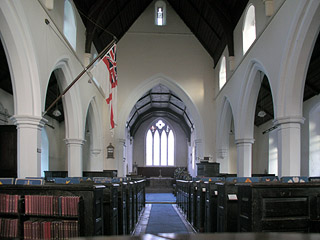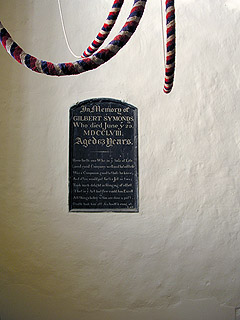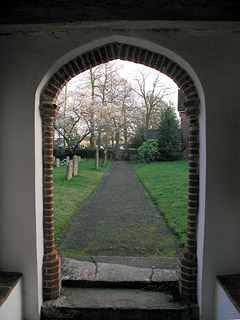St Mary, Brinkley is, if I must be frank, a little dull on the outside. Most of it looks depressingly Victorian: the windows are all very new, and the walls have horizontal bands of ochre stone punctuating the flint surface.
The only real features of interest are the west tower and the porch. The former is a nice 13th century structure with a fine chequered flushwork base course, and diagonal buttresses. It's mostly quite plain, but the west window is grand and Perpendicular.
It's quite unusual to see flushwork here in Cambridgeshire, but Brinkley is very close to the Suffolk border and it's natural that there would be some stylistic influences crossing over.
Another influence - this time from Essex - can be seen in the brick porch. This is a little rounded structure of warm red brick, complete with big corner buttresses and a little statue niche over the doorway. It was added to the church under the Tudors. Again, it's quite unusual to see Tudor brickwork on churches in Cambridgeshire (though, of course, it's omnipresent in the Cambridge colleges), but much more common in Essex. It's almost amusing to see two different vernacular traditions making themselves felt here.
Inside, the extent of the Victorian restoration is clear. The basic structure is old, but it was given a very thorough scrubbing up between 1874 and 1875, when the chancel and clerestory were rebuilt, new aisles were put in and the nave was repainted and refloored. It leaves everything feeling a bit sterile, but there are some interesting things left for us to have a look at.
The tower arch, for example, is very tall and thin, and the space under the tower is bright and airy due to the big west window. Under the tower there is an early 17th century clock mechanism. I doubt that it could be brought back into working order, but it's an interesting survival.
Moving eastwards, there is some nice woodwork dotted around the nave. The pulpit is 18th century, and it contains some good 17th century panels that have been reused. The squire's pew - directly beneath the hymn board - contains similar panels. None of the rest of the pews struck us as notable, but they're all quite nice: tall and dark. Better than benches, anyway.
Up above the chancel arch is a little window. The chancel arch itself is Perpendicular, having been preserved when the chancel was rebuilt. The restoration of this was quite sensitive; the east window was either reinserted or a very faithful copy put in. Bits of medieval glass survive in the top, with angels censing on either side of the central quatrefoil.
Also in the chancel is a wall monument to the infant daughter of Christopher Anstey, who was rector here in the 18th century. I'm not usually in the habit of noting wall monuments unless they're very interesting, but I liked the painted coat of arms on this one.
[Mark adds: I liked the memorials in this church, there's the one to baby Anne - died at 4 months - that Ben mentions and there's also a splendid one to a bell ringer under the tower, one Gilbert Symonds. it's not too readable in the size of picture I can get away with here, here's the poem:.
Here lieth one Who in ye time of Life
Loved good Company well and hated ftrife
Was a Companion good to thofe he knew.
And often would put forth a Jeft or two;
Took such delight in Ringing of a Bell
That in ye Art but few could him Excell
All things below with him are done & paft.
Death took him off, his knell is rung at laft. ]
More interesting is the plaque in the north aisle commemorating Sir Geoffrey Keynes and his wife Margaret, who died in 1982 and 1974 respectively. Geoffrey and Margaret were members of two of the greatest academic dynasties in 19th and early 20th century Britain. Sir Geoffrey was the brother of John Maynard Keynes, the great economist. Like his brother, he was something of a polymath: he was both a notable surgeon and a great expert on William Blake. Margaret Keynes was a member of the Darwin family: the daughter of Sir George Howard Darwin (one time Plumian Professor of astronomy) and granddaughter of Charles Darwin himself.
At the time we visited Brinkley I had just read Noel Annan's essay 'The Intellectual Aristocracy', in which he traced the various connections between the great academic families of Britain: the Russells and Wedgwoods and Darwins and Keyneses and Rothschilds. It was a bit startling, then, to find two of the leading characters commemorated in this little church.
I finished making my notes, and followed Mark outside. The sun was setting, and I stopped to appreciate the churchyard for a moment. Buildings lap the south-west corner, and the western edge is bounded by a fine brick wall. Early blossom was out on a tree by the gate, and rooks were calling in the tops of the great bare beech trees. For a moment, everything was perfect - then we continued on our journey.
St Mary was open when we visited.





